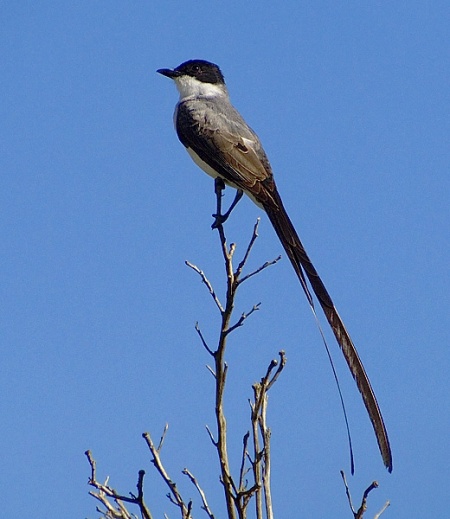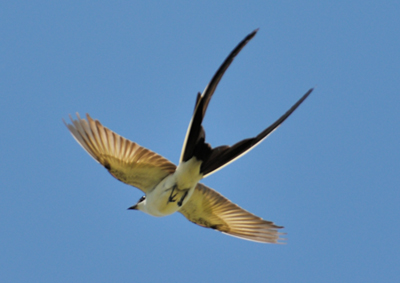- Tyrannus savana
Identification
Male 37–40·5 cm (14½-16 in), female 28–30 cm (11-11¾ in) includes length of tail
- Black head
- Yellow crown stripe (not always visible)
- Pale grey back
- White underparts
- Juvenile has the same coloration, but only a short tail.
Sexes similar.
Distribution
Central America and South America.
Relatively regular vagrant to North America.
Taxonomy
Subspecies
There are 4 subspecies[1]
- T. s. savana:
- T. s. monachus: has a lighter back than nominate
- T. s. sanctaemartae:
- T. s. circumdatus:
- Lower Amazonian Brazil (west to Manaus area)
Habitat
Found in a wide variety of habitats; light forests, city parks, riverine, humid forests, open fields near rainforest edge, grassland, Pacific lowlands, highly disturbed dry tropical forest with open pastures for grazing cattle, savannas. Open areas, agricultural field with scattered trees, scrubby farmland
Observed at heights around 20-29 m.
Behaviour
Diet
Their diet consists of flying insects during the breeding season with the addition of fruit (berries and palm fruit) at other times.
References
- Clements, J. F., T. S. Schulenberg, M. J. Iliff, D. Roberson, T. A. Fredericks, B. L. Sullivan, and C. L. Wood. 2018. The eBird/Clements checklist of birds of the world: v2018. Downloaded from http://www.birds.cornell.edu/clementschecklist/download/
- Arthur Grosset
- Handbook of the Birds of the World Alive (retrieved December 2016)
- BF Member observations
Recommended Citation
- BirdForum Opus contributors. (2024) Fork-tailed Flycatcher. In: BirdForum, the forum for wild birds and birding. Retrieved 25 April 2024 from https://www.birdforum.net/opus/Fork-tailed_Flycatcher
External Links
Search the Gallery using the scientific name:
GSearch checked for 2020 platform.1






